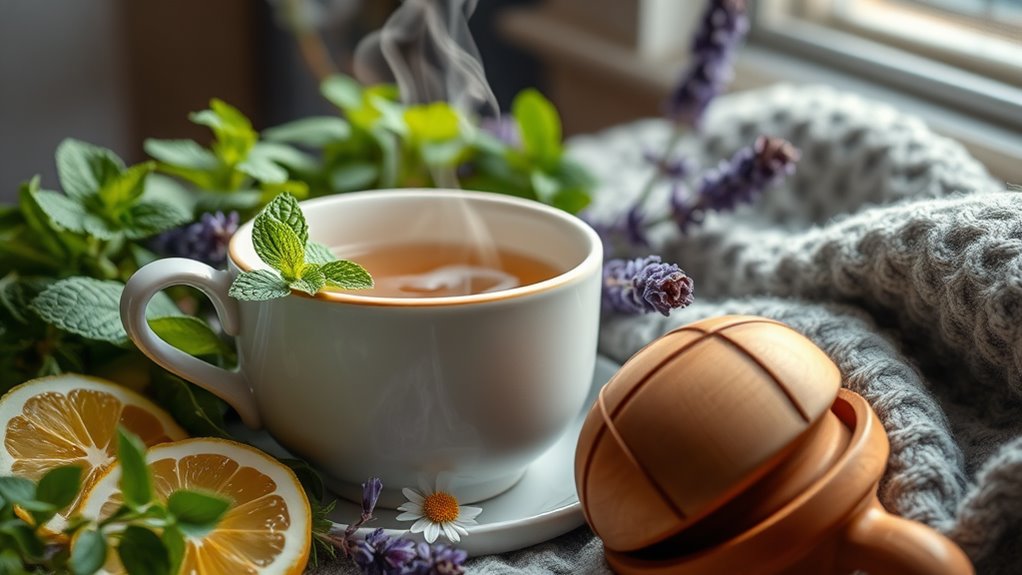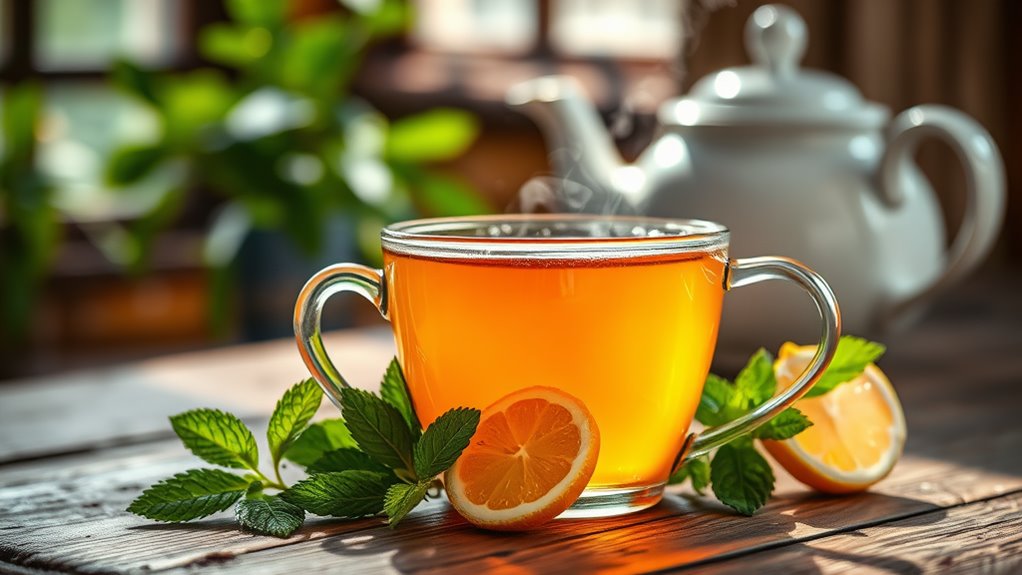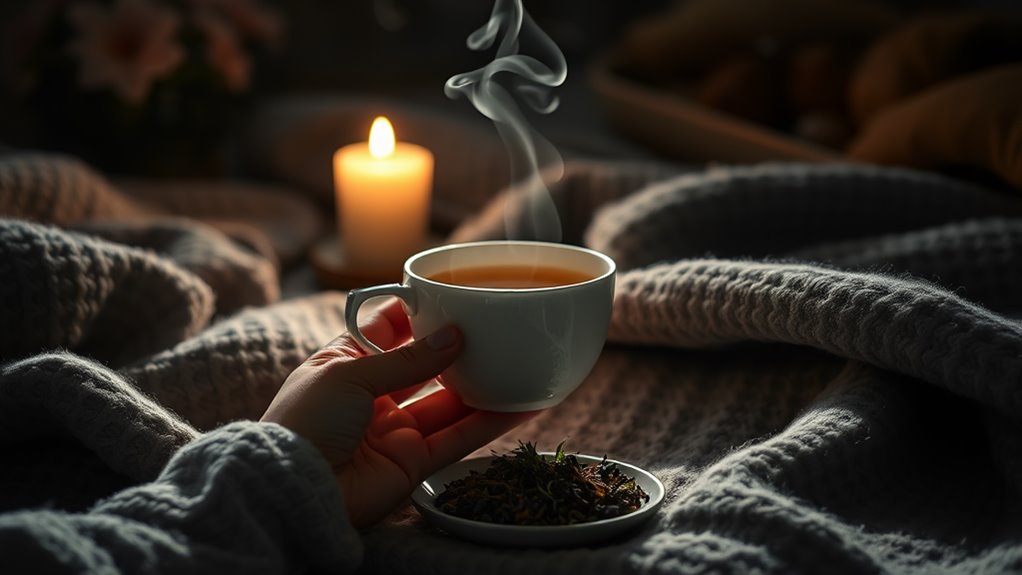A Soothing Herbal Tea Recipe to Wind Down With
To wind down, brew a calming herbal tea with chamomile and lavender. Simply steep 1-2 teaspoons of these soothing herbs in freshly boiled water for 5-10 minutes. Add honey for sweetness or a splash of lemon for a refreshing twist. The warmth of your tea invites tranquility, helping ease your mind after a long day. Create a cozy atmosphere with soft music or candles, and discover more delightful tips for enhancing your tea experience.
Key Takeaways
- Combine chamomile, lavender, and passionflower for a calming herbal blend that promotes relaxation and restful sleep.
- Boil fresh, filtered water and steep your chosen herbs for 5 to 10 minutes for optimal flavor infusion.
- Enhance your tea with honey for sweetness or a splash of lemon for a refreshing, vitamin C boost.
- Create a tranquil ambiance by dimming lights, playing soft music, and using essential oils to elevate your tea experience.
- Store unused herbs in airtight containers in a cool, dark place to maintain freshness and potency.
The Benefits of Herbal Tea for Relaxation
When you find yourself feeling overwhelmed, sipping on a warm cup of herbal tea can be a simple yet powerful way to invite relaxation into your day.
Herbal teas have long been celebrated for their calming properties, making them an ideal choice for winding down. A soothing bedtime tea, for instance, can help ease your mind and prepare your body for restful sleep.
The warmth of the tea not only comforts you but also promotes a sense of tranquility. Infusions like chamomile and lavender are particularly effective, as they contain natural compounds that support relaxation. Additionally, many herbal teas are crafted using natural ingredients that enhance their soothing effects.
Taking just a few moments to savor your tea can create a mindful ritual, turning a hectic day into a serene evening, and nurturing your overall well-being.
Key Ingredients for a Soothing Brew
When crafting your soothing herbal tea, it’s essential to choose calming herbs that promote relaxation and peace. Think about adding flavor enhancements that not only elevate the taste but also contribute to the overall soothing experience. Let’s explore the perfect ingredients that will make your brew a comforting ritual. Including calming ingredients like chamomile, valerian root, and lavender can significantly enhance your tea’s effectiveness in promoting better sleep.
Calming Herbs Overview
Several calming herbs can transform your tea into a soothing ritual, promoting relaxation and peace.
Chamomile is a classic choice, known for its gentle sedative properties that help ease anxiety and encourage sleep.
Lavender, with its fragrant aroma, invites tranquility and can reduce stress levels.
Passionflower is another wonderful herb that calms the mind, making it easier to unwind after a long day.
Then there’s lemon balm, which brightens your spirit while also soothing nerves.
Finally, valerian root, though strong in taste, is highly effective in promoting restful sleep.
Incorporating these herbs into your tea not only nurtures your body but also creates a sacred space for self-care and mindfulness, inviting a moment of stillness into your day.
Flavor Enhancements Options
To create a truly soothing brew, consider adding flavor enhancements that elevate both the taste and therapeutic qualities of your herbal tea. Fresh lemon balm or a squeeze of lemon can brighten your tea, while a hint of honey adds natural sweetness and soothing properties.
For a touch of warmth, ginger offers not just flavor but also digestive support. Cinnamon sticks can infuse a comforting spice, enhancing relaxation. You might also explore adding a few sprigs of fresh mint for a refreshing twist.
Don’t forget about vanilla or almond extract—just a drop can transform your tea into a nurturing experience. Each enhancement not only enriches the flavor but also connects you to the calming essence of nature. Enjoy your soothing ritual!
How to Choose the Right Herbs
Choosing the right herbs for your soothing tea can transform your experience, especially when you consider your specific needs and preferences.
Start by reflecting on what you’re hoping to achieve—whether it’s relaxation, digestion, or immune support. Herbs like chamomile and lavender are perfect for calming the mind, while peppermint can aid digestion. If you’re looking for something invigorating, ginger might be your go-to.
Think about flavor too; some herbs are more aromatic and can enhance the overall taste of your tea. It’s also wise to consider any allergies or sensitivities you may have. Additionally, incorporating herbs known for their skin-clearing properties can provide added benefits for your skin while you unwind.
Step-by-Step Tea Preparation
Making your soothing herbal tea is a simple yet rewarding process that can elevate your self-care routine. Start by boiling fresh, filtered water in a kettle. While it heats, measure one to two teaspoons of your chosen herbs, ensuring they’re fresh or high-quality dried ones.
Once the water’s boiling, remove it from heat and add the herbs to a teapot or infuser. Pour the hot water over the herbs, cover, and let steep for about five to ten minutes. This allows the flavors and healing properties to infuse. Additionally, consider incorporating calming ingredients like chamomile or lavender for an extra soothing effect.
After steeping, strain the tea into your favorite mug. Take a moment to appreciate the aroma and warmth before sipping, embracing the calming experience you’ve just created.
Enhancing Flavor With Natural Additives
Once you’ve brewed your soothing herbal tea, enhancing its flavor can transform your experience into something even more delightful. Natural additives not only boost taste but also contribute to your overall well-being. Here are some great options to consider:
| Additive | Flavor Profile | Benefits |
|---|---|---|
| Honey | Sweet, floral | Soothes sore throats |
| Lemon | Citrusy, bright | Rich in vitamin C |
| Ginger | Spicy, warming | Aids digestion and soothes |
Adding any of these can elevate your tea ritual. Experiment and find the perfect balance that resonates with you. Remember, it’s all about nurturing your spirit and enhancing that calming moment of self-care. Enjoy every sip!
The Perfect Brewing Time and Temperature
While brewing your soothing herbal tea, it’s essential to pay attention to both time and temperature to unlock the full potential of the herbs.
Begin by heating your water to just below boiling, around 200°F (93°C), as this helps extract the delicate flavors and beneficial properties without scalding the herbs.
Once your water’s ready, steep the tea for about 5 to 7 minutes. This allows the herbs to release their soothing compounds, creating a calming infusion.
If you prefer a stronger flavor, you can steep a bit longer, but be mindful not to overdo it, as bitterness may creep in.
Trust your instincts, and enjoy the aromatic journey that unfolds with each cup. Your body and mind will thank you.
Tips for Creating a Cozy Tea Ritual
Creating a cozy tea ritual starts with choosing your favorite teas that resonate with you.
Take a moment to set the atmosphere—soft lighting and calming music can make all the difference.
Embrace this time for yourself, allowing each sip to nurture your soul.
Choose Your Favorite Teas
There’s something truly special about selecting your favorite teas for a cozy ritual. As you browse through your collection, think about the flavors and aromas that resonate with you.
Whether you lean towards calming chamomile, invigorating peppermint, or grounding rooibos, each choice can enhance your experience. Consider the time of day and your mood—lighter teas in the morning, heartier blends in the evening.
Don’t hesitate to mix and match; herbal blends can create unique flavors that cater to your senses. Pay attention to the colors and textures of the dried leaves; they invite your curiosity.
Ultimately, this process isn’t just about tea; it’s an opportunity to connect with yourself, nurturing your spirit during those quiet moments.
Set the Atmosphere
The right atmosphere can transform your tea experience into a soothing ritual. To cultivate a cozy environment, consider dimming the lights, lighting a candle, or using gentle fairy lights. Soft music or nature sounds can enhance the tranquility. Here’s a simple guide to help you create your ideal tea setting:
| Element | Suggestions | Benefits |
|---|---|---|
| Lighting | Dim lights or candles | Creates a warm ambiance |
| Sound | Soft music or nature sounds | Encourages relaxation |
| Scent | Essential oils or incense | Uplifts mood and calms |
Alternative Herbal Blends to Try
If you’re looking to expand your herbal tea repertoire, exploring alternative blends can be a delightful journey.
Consider trying chamomile and lavender for a calming brew that eases stress and promotes restful sleep. If you’re seeking something invigorating, ginger and turmeric provide a warming, spicy kick while supporting digestion.
For a refreshing twist, mint and lemongrass offer a zesty flavor profile that uplifts your mood. You might also enjoy rooibos and vanilla, which create a naturally sweet and caffeine-free option.
Each blend carries its unique benefits, so don’t hesitate to experiment and discover what resonates with you. Creating your own herbal tea blends can be a nurturing ritual, allowing you to tailor your experience to your personal preferences and needs.
Storing Your Herbal Tea for Freshness
While you may be eager to enjoy your herbal tea blends, proper storage is essential for maintaining their freshness and potency.
To ensure your teas stay vibrant and flavorful, consider these simple tips:
-
Use airtight containers: Glass jars or metal tins can protect your herbs from moisture and air exposure.
-
Keep in a cool, dark place: Light and heat can degrade your tea’s quality, so store them away from sunlight and heat sources.
-
Label with dates: Marking when you purchased or opened your blends helps you use them at their best.




